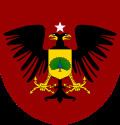Final ruler William of Albania | ||
 | ||
Country Albania (Principality of Albania), Wied, Wied-Neuwied Titles King of Albania (Prince)
Prince of Wied-Neuwied Founded c. 860
1914 (as royal house) Founder Matfried I
William of Albania (as royal house) Current head Maximilian, Prince of Wied | ||
The House of Vidi or House of Wied (Albanian: Oxhaku i Vidve or Shtëpia e Vidve) is a European dynasty founded by William of Albania, Skanderbeg II reigned briefly as sovereign of Principality of Albania as Vidi I from 7 March 1914 to 3 September 1914 when he left for exile. His reign officially came to an end on 31 January 1925 when the country was declared an Albanian Republic.
Contents
Outside the country and in diplomatic correspondence, William was styled "sovereign prince", but in Albania he was referred to as "mbret", or king. He was also styled Skanderbeg II, in homage to Skanderbeg, the national hero.
The current head of the dynasty is Maximilian, Prince of Wied, who succeeded his father, Carl, Prince of Wied in March 2015.
Wied
Wied was a County of Rhineland-Palatinate, Germany, located on the river Wied where it meets the Rhine. Wied emerged as a County earlier than many other German states. From 1243–1462, Wied was united with an Isenburgian County as Isenburg-Wied. Wied was partitioned twice: between itself and Wied-Dierdorf in 1631, and between Wied-Neuwied and Wied-Runkel in 1698.
Counts of Wied (c. 860–1243)
To Isenburg-Wied (1243–1462)
Counts of Wied (1462–1698)
Partitioned between Wied-Neuwied and Wied-Runkel
Wied-Neuwied
Wied-Neuwied was a German statelet of northeastern Rhineland-Palatinate, Germany, located northeast of the Rhine River, north and inclusive of Neuwied. Wied-Neuwied was a partition of Wied, and was raised from a County to a Principality in 1784. Prince Alexander Philip Maximilian was the second son of Prince John Frederick Alexander and was a famous explorer, ethnologist and naturalist. Wied-Neuwied was mediatised to Nassau and Prussia in 1806.
European Great Powers — Austria-Hungary, the United Kingdom of Great Britain and Ireland, the French Third Republic, the German Empire, the Russian Empire and the Kingdom of Italy — selected William, a member of the German princely house of Wied, to rule over newly independent Albania. The announcement was made in November 1913 and the decision was accepted by Ismail Qemali, the head of the provisional government. The offer of the Albanian throne was first made to him in the spring of 1913 but he turned it down. Despite rejecting the offer, the Austrians put pressure on Prince William in an attempt to change his mind.
Western Europeans considered Albania to be a poor, lawless and backward country in 1913, and some foreign opinion was scathing. The French press referred to Wilhelm as "le Prince de Vide", meaning "the prince of emptiness"; vide being a pun on his homeland of Wied.
Principality of Albania
The Principality of Albania (Albanian: Principata e Shqipnis` or Shteti Shqiptar), refers to the short-lived monarchy in Albania, headed by William, Prince of Albania and to the state after the First World War, until the abolition of the monarchy in 1925, when Albania was declared a republic.
The Principality of Albania was established on February 21, 1914. Albania had been under Ottoman rule from around 1478 until the Treaty of London in May, 1913 when the Great Powers recognised the independence of Albania. The Great Powers selected Prince William of Wied, a nephew of Queen Elisabeth of Romania to become the sovereign of the newly independent Albania. A formal offer was made by 18 Albanian delegates representing the 18 districts of Albania on February 21, 1914, an offer which he accepted. Outside of Albania William was styled prince, but in Albania he was referred to as Mbret (King) so as not to seem inferior to the King of Montenegro. The first government under the rule of the House of Wied was a kind of a "princes privy council" because of its members, who were representatives of the Albanian nobility : Prince Turhan Pasha Përmeti, former Governor of Crete and ambassador of the Ottoman Empire at Saint Petersburg, Aziz Pasha Vrioni, Prince Bib Doda of Gjomarkaj-Mirdita, Prince Essad Pasha Toptani, Prince George Adamidi bey Frashëri (Frachery), Mihal Turtulli bey Koritza, etc.
Prince William arrived in Albania at his provisional capital of Durrës on March 7, 1914 along with the Royal family. The security of Albania was to be provided by an International Gendarmerie commanded by Dutch officers. William left Albania on September 3, 1914 following a pan-Islamic revolt initiated by Essad Pasha and later taken over by Haxhi Qamili the military commander of the Peasant Revolt in Albania centered in Tirana. However he never renounced his claim to the throne.
